※Supervised by Junko Ashitomi
- Jushi
- Rice cooked with pork and vegetables in pork broth
Jushi
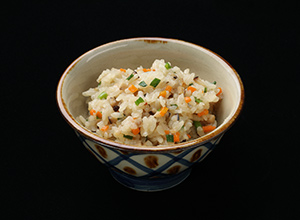
- ■ Ingredients
- rice 2C
- pork broth 2 1/4~2 1/2C
- (or pork broth + dried bonito broth)
- salt Teaspoon1~1 1/2
- soy sauce Tablespoon1~1 1/2
- pork rib 150g
- carrots 30g
- 2 dried shiitake mushrooms
- boiled fish paste 30g
- lard or salad oil Teaspoon1~2
- green onion 3~5本
- ①Wash rice 30 minutes before cooking, put it in a basket and let the water drain off.
- ②Boil the whole pork rib and chop it into 5 mm squares
- ③Chop carrots, rehydrated dried shiitake mushrooms and boiled fish paste.
- ④Put pork broth, salt and soy sauce in a pot just before cooking, then add rice in (1), pork rib in (2) and chopped vegetables in (3), and cook.
- ⑤When it’s cooked, add lard, and mix the ingredients, then add finely chopped green onion, and steam the cooked rice.
■Using hot pork broth might leave a hard core at the center of the rice grains.
■If rice is cooked with lard or oil, it will hardly suck water because of the coating made by lard or oil.
■When you cook a small amount of rice, cook it over a high flame without covering the pot with a lid, and cover the pot with the lid to avoid burning when you see some holes on the rice.
■The cooked rice should be accompanied with a vinegared dish.
- Innards soup
- Clear soup with innards (pig large intestine, small intestine and stomach)
Innards soup
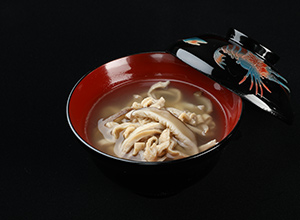
- ■ Ingredients
- innards (pig large intestine small intestine and stomach) 250g
- a suitable tofu refuse
- a suitable amount of ginger
a suitable amount of orange-peel - 2 dried shiitake mushrooms
- pork broth 2 1/2C
- dried bonito broth 2 1/2C
- salt Teaspoon1 1/4
- a small amount of soy sauce
- a minuscule amount of long pepper
- (or grated ginger)
- ①Take out the fat of innards carefully, clean them well with tofu refuse, and wash them with hot water carefully. If you put tofu refuse on innards and leave them overnight, the smell will be gone.*1
- ②Put all the innards in a pot, add a lot of water and put the pot over a fire. When it comes to a boil, spill the hot water and wash them, then add water again and when it comes to a boil, spill the hot water. Repeat this 6-7 times. When the smell is gone, add ginger and orange-peel and boil them until tender for about 2 hours.
- ③Boiling time for stomach, that for large intestine and that for small intestine are different. So take out the softened ones. *2
- ④Cut the innards in (2) into 5cm long x 7mm wide.
- ⑤Rehydrate dried shiitake mushrooms with water and shred it.
- ⑥Put a suitable amount of broth in a pot and boil it. Then add innards and rehydrated dried shiitake, season them with salt, add a little soy sauce like clear soup, and cook over a medium flame for a while.
- ⑦Put the innards and soup in a bowl, and sprinkle long pepper.
※1 There are several ways to remove the smell. Another way is to fry innards with flour, vinegar and light galangal with low-temperature oil.
※2 Generally, the cooked innards are sold.
- Inamuduchi
- White miso thickened soup with lots of ingredients
Inamuduchi
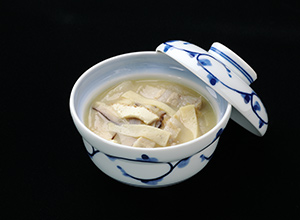
- ■ Ingredients
- pork rib 160g
- 2 dried shiitake mushrooms
- Konnyaku 160g
- thick deep-fried tofu 100g(or 2 thin deep-fried tofu)
- sponge cake boiled fish paste 80g
- pork broth 2C
- dried bonito broth 2C
- white miso(sweet)*1 80~106g
- ①Boil the whole pork rib and cut it into rectangular slices of 4cm long x 1cm wide. Then put salt on the slices and leave them for a while.
- ②Put the sliced pork rib in boiled water quickly and wash it. (Take out the salt and greasiness.
- ③Cut all the ingredients into rectangular slices, and boil Konnyaku quickly.
- ④Put a suitable amount of pork broth and dried bonito broth in a pot and boil it. Add pork rib and rehydrated dried shiitake mushrooms, and boil them. Then add Konnyaku and a thick deep-fried tofu, and put white miso.
- ⑤Boil it over a medium flame for 10-15 minutes. When the ingredients absorb the seasoning and are softened, add sponge cake boiled fish paste for finishing up.
※1 Miso usage is subject to change depending on the amount of salt in white miso (6-8%)
See the following calculation formula.
[Salt content: 0.8% of the soup]
800cc × 0.8% = 6.4g
[Calculate from the amount of salt in miso]
If you use miso with salt content of 6%, the salt content in 100g of miso is 6g.
So the needed amount of miso with the salt content of 6% is 106g.
■Adjust the thickness depending on the climate. (If it’s cold, make the soup thick.)
- Squid ink soup
- Black rich-flavored soup with squid ink
Squid ink soup
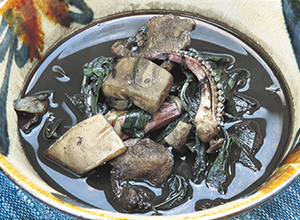
- ■ Ingredients
- White squid (bigfin reef squid) 500g
- pork 150g
- lxeris 150g
- squid ink Tablespoon1~2
- water 8C
- salt Teaspoon1
- ①Take out the ink sac from a white squid. Open the body of the squid, peel the skin and wash it. Cut the body and legs into 5cm long x 1.5cm wide.
- ②Cut raw pork into thin slices.
- ③Cut Ixeris into the suitable length.
- ④Spread Ixeris in a pot, and put white squid and pork on the Ixeris. Then add a suitable amount of water and put it over a fire. When it boils and the scum rises to the surface, skim off that carefully, and boil it over a low flame until tender for about 1 hour.
- ⑤If the broth becomes less than 5 cups, add dried bonito broth, season it with salt, and mix squid ink into the soup at the end.
- Irabu Shinji (liquid made from the boiled down blue-lipped sea krait)
- Liquid made from the boiled down Irabu, Nuchigusui (Medicine for longevity)
Irabu Shinji (liquid made from the boiled down blue-lipped sea krait)
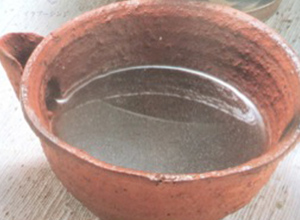
- ■ Ingredients
- 1 Irabu (smoked) 1本
- a suitable amount of rice bran
a sheet of kelp - water 15C
- ①Broil the skin of Irabu on an open fire gently, and bring the grease to the surface. Knead rice bran in tepid water, put it on the Irabu and wash the surface by rubbing it with hands carefully. Then cut it into 6cm long by a knife or saw.
- ②Wash kelp and rehydrate it.
- ③Bring the opening of the Irabu in (1) to the top and bundle it. Wrap it with kelp and tie it up with kite strings.
- ④Put the Irabu in (3) and 15 cups of water in a pot and put the pot over a fire. Once it boils, turn down the flame and boil it slowly for 7-10 hours until the liquid is reduced to one third (about 5 cups). Don’t cover the pot with a lid, and take out the scum carefully.
- ⑤Take out the Irabu and strain the broth.
- Irabu soup
- Soup with Irabu, pig’s trotters, kelp and Irabu Shinji
Irabu soup
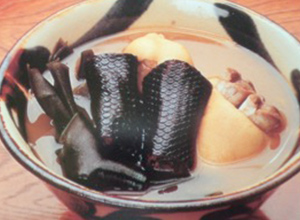
- ■ Ingredients
- Suitable amount of Irabu Shinji
- 7 cups of water
- 8 pieces of Irabu
- a sheet of kelp
- 4 pig’s trotters (Chimagu)
- 10 cups of water
- Awamori Tablespoon3
- salt
- a small amount of soy sauce
- ①Remove the kelp from the Irabu after taking Irabu Shinji and cut the ventral side (where there are no scales) of each piece of the Irabu lengthwise to open the body and remove the guts and bones from the Irabu. Put the guts and bones in a soup stock bag.
- ②Wind up the Irabu to form a good shape, and tie it with threads not to get loose.
- ③Rehydrate kelp with water and make knots with the kelp.
- ④Put Irabu Shinji, the wound up Irabu, kelp and water in a pot, and put the pot over a fire. Once it boils, turn down the flame and boil it for 2 hours, removing the scum. Take out the kelp when it becomes soft in the middle.
- ⑤Cut the kelp by knot.
- ⑥Wash pig’s trotters in hot water and boil them for 10 minutes. (If hair is left, remove the hair with tweezers.)
- ⑦Put the boiled trotters in (6), water and Awamori in a pot, and put the pot over a fire. Once it boils, turn down the flame and boil it for 2-3 hours (until the skin becomes soft and it can be easily removed from the bones).
- ⑧Strain the broth (because it contains collagen).
- ⑨Mix the Irabu broth in (4), pork broth, pig’s trotters, and kelp in a pot, and season with salt like clear soup. (If you use soy sauce instead of salt, use just a small amount because soy sauce removes the smell of Irabu.)
- ⑩Put pig’s trotters, kelp and Irabu in a bowl and pour the broth.
- Rafute
- Boiled cubes of pork rib. Seasoned with sugar, soy sauce and Awamori
Rafute
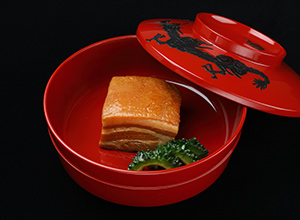
- ■ Ingredients
- pork rib 700g dried bonito broth 4と 1/2C(or pork broth)
- Awamori (20-30% of the weight of pork)
- sugar
- soy sauce (koikuchi)
- soy sauce (usukuchi)
- ①Broil pork rib on an open fire lightly, and soak it in hot water quickly.
- ②Put hot water in a thick pan. When it boils, put the block of pork rib in (1), skim off the scum and boil it over a low flame until tender for about 1 and half hours., then cool it off (While cooling it off, press the pork for shaping).
- ③Cut the pork rib into 4-5 cm squares. Weigh the pork rib and calculate the necessary amount of seasoning in accordance with the weight.
- ④Put a suitable amount of broth and Awamori in a pot, and put the pot over a fire. Boil it over a low flame for an hour (Remove the scum and fat).
- ⑤Next, add sugar and boil it for an hour, then add half of the soy sauce, and boil it for 2 hours. At the end, add the rest half of the soy sauce and boil it for another 2 hours.
- ⑥When the pork rib becomes tender enough to be cut with chopsticks, turn off the fire.
- ※Boil it without a lid.
■Weigh the weight of the pork rib before boiling and adjust the amount of seasoning as follows.
Seasoning ratio (based on the weight of pork)
sugar 4~4.5%
salt content (soy sauce) 1.5~2.0%
[Guide to use]
white soft sugar Tablespoon1=9g Teaspoon1=3g
soy sauce (salt) Tablespoon1=3g Teaspoon1=1g
- Duluwakashi
- Dish of taimo, stems of taimo, pork kneaded with pork broth
Duluwakashi
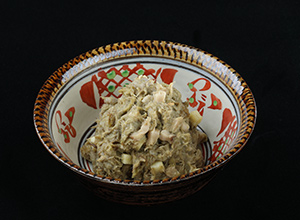
- ■ Ingredients
- taimo 300g
- stems of taimo 350g
- pork rib 40~70g
- 2 dried shiitake mushrooms
- green peas 30g
- sponge cake boiled fish paste 30g
- pork broth 1~1 1/2C
- lard or salad oil Tablespoon1/2
- a small amount of salt
- ①Wash stems of taimo, and cut them into 3 cm long. Soak them into water to remove their astringency. Boil them in hot water until tender, and drain water well.
- ②Peel the skin of taimo, cut it into big pieces, and boil it. Mash it when it’s hot.
- ③Boil the block of pork rib, and cut it into 4mm squares.
- ④Rehydrate dried shiitake mushrooms with water and cut them into 4mm squares.
- ⑤Heat lard in a pot and fry pork rib until fat comes out, then fry stems of taimo and shiitake mushrooms. Add taimo and pork broth, and boil them, by kneading them with a wooden ladle.
- ⑥Knead them enough until they become paste. Add green peas and sponge cake boiled fish paste, then season them with salt.
■Stems of taimo are very astringent. If you touch them with your bare hands, you will get a rash. So please use vinyl gloves.
■If stems of taimo are too large, peel the skin like pulling strings.
■Sometimes it can be seasoned with miso.
- Rolled kelp (Kombu maki)
- Dish of rolled kelp with fish in it
Rolled kelp (Kombu maki)
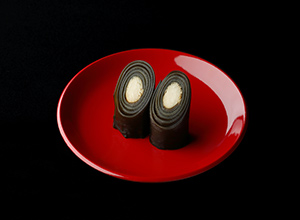
- ■ Ingredients
- 3 sheets of kelp(70g)
- white fish 300g
- dried bonito broth 11C
- soy sauce Tablespoon2 1/2
- sweet cooking sake Tablespoon2 1/2
- sugar 1/2C
- ①Wash kelp well and rehydrate it, drain water well, and cut it into 4-5 equal pieces.
- ②Cut white fish into cylindrical shape in accordance with the width of kelp. Wrap this with kelp and roll it. Put 2 rolls together and hold them with a toothpick.
- ③Boil dried bonito broth in a pot. Spread the rolled kelp in the pot, cover it with an in-pot lid, and boil it for a while. Add sake, sugar, salt and soy sauce in the middle and boil it until it’s well flavored.
- Burdock root roll (Gobo maki)
- Dish of rolled burdock root wrapped with pork
Burdock root roll (Gobo maki)
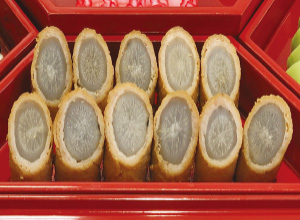
- ■ Ingredients
- 8 thin slices of pork loin
- 1 burdock root (medium thickness)
- dried bonito broth 2C
- soy sauce 40cc
- sweet cooking sake 40cc
- sugar Tablespoon4
- ①Scrape the skin off a burdock root and adjust the shape. Cut it into 8 cm long, boil it and cool it down.
- ②Beat pork loin and make it thinner, and wrap burdock root with it. Spread the burdock root roll in a pot, putting the end part of the roll on a pot. By stretching the pork meat of the end part of the roll, it will be absorbed and look well.
- ③Put dried bonito broth and seasoning in the pot, cover it with an in-pot lid, and boil it slowly.
- Jimami-dofu (Okinawa peanut tofu)
- Dish of Jimami (peanuts) kneaded with sweet potato starch like tofu
Jimami-dofu (Okinawa peanut tofu)
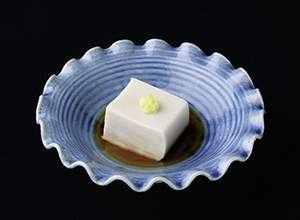
- ■ Ingredients
- raw peanuts 2C
- sweet potato starch 1C
- water 6C
- [dipping sauce]
- dried bonito broth Tablespoon5
- usukuchi soy sauce Tablespoon1 ~1 1/2
- sweet cooking sake Tablespoon1
- a small amount of grated ginger
- ①Soak raw peanuts in hot water. When the hot water becomes less hot, peal the skin of the peanuts and wash them.
- ②Put the peanuts in (1) and about half of the water (3 cups) in a blender. When the peanuts become smooth (without rough deposits), put them in a bowl and squeeze them. (The squeezed juice will be used later). *1
- ③Dissolve sweet potato starch in the rest of water (3 cups), and strain it.
- ④Put the squeezed juice in (2) in a thick pot, and boil it over a medium heat. When it boils and the smell of raw peanuts has gone, add the dissolved sweet potato starch and mix them, kneading them constantly with a ladle. When it hardens, turn down the flame to medium one. Then the hardened stuff will be softened again.
- ⑤When you keep kneading it for about 30 minutes, the milky white liquid will become sticky and glossy. And when it becomes paste until it can be scooped up with a wooden pestle, turn off the fire.
- ⑥Spread a wet dish towel on a can mold, pour the paste in (5) into the can mold quickly, level out the surface, and cool it down to harden it by putting it in water.
- ⑦Put dried bonito broth, usukuchi soy sauce and sweet cooking sake in a small pot, and boil it, then cool it down for preparing dipping sauce.
- ⑧Pour a small amount of dipping sauce in a bowl, arrange the Jimami tofu cut into a suitable size, and put grated ginger on it.
*1 If you squeeze them too strongly, a dish towel might be broken. So make the towel dual and make a bag.
■You can check the degree of kneading by putting a small amount of it into iced water.
- Minudaru
- Dish of pork loin flavored with black sesame sauce and steamed
Minudaru
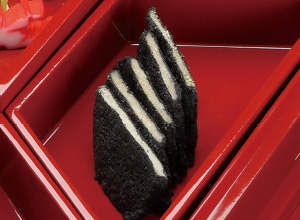
- ■ Ingredients
- 8 pieces of pork loin (thickness)
- black sesame 100g
- dipping sauce ratio
- soy sauce Tablespoon2
- sweet cooking sake Tablespoon2
- sugar Tablespoon2
- sake Tablespoon1
- ①Cut off the fat from the pork loin or cut the muscle of the pork, and tap the pork with the back of a knife lightly. Soak it in a suitable amount of dipping sauce for 2-5 hours, and let the water drain off.
- ②Roast black sesame and rub it well until the oil comes out. Add the dipping sauce in (1), rub it well and mix it to make thickened sesame sauce.
- ③Wipe off the moisture of the pork in (1) and put the sesame paste in (2) on the pork.
- ④Spread a sheet of cooking paper in a heated steamer, and arrange the pork in (3). Steam it over a high flame heat for the first 2-3 minutes, then turn down the flame to medium one, and steam it for about 10-15 minutes, depending on the thickness of the pork and cool it down.
- Urachikichinuku
- Dish of steamed fish paste on small shiitake mushrooms
Urachikichinuku
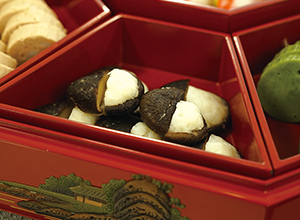
- ■ Ingredients
- 8 dried shiitake mushrooms (small ones)
- [sauce]
- dried bonito broth 1/2C
- soy sauce Teaspoon1
- sweet cooking sake Teaspoon1
- sugar Teaspoon1/2
- fish paste 200g
- potato starch Teaspoon2
- ①Prepare small and good shaped dried shiitake mushrooms. Rehydrate them in water and take off hard tips. Soak them in the sauce and wipe off the moisture.
- ②Put a little potato starch on the shiitake mushrooms, and put fish paste on them thickly. Steam them for about 15 minutes.
- Stir-fried and boiled kelp
- Dish of shredded kelp fried and boiled with ingredients
Stir-fried and boiled kelp
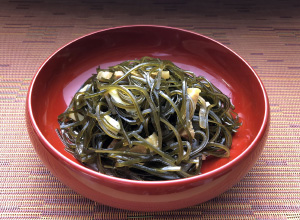
- ■ Ingredients
- long slice of kelp or shredded kelp 40g
- pork rib 75g
- soy sauce Tablespoon2 1/2~3
- sugar Tablespoon2 1/2
- Awamori Tablespoon1 1/2
- sweet cooking sake Teaspoon2
- Konnyaku 80g
- red boiled fish paste 40g
- salad oil Tablespoon2
- pork broth 2 1/2~3C
- a small amount of salt
- ①Wash a long slice of kelp and rehydrate it with water. Let the water drain off in a basket and shred it.
*1 Leave the shredded kelp as it is and wash it, then soak it in water until the curls are removed. When it’s straightened, wash it again and let the water drain off. - ②Boil the block of pork rib and cut it into rectangular slices.
- ③Cut Konnyaku into rectangular slices, and boil it from water.
- ④Put soy sauce, sugar and Awamori in a small pot, and boil it. Then put the pork rib in it and infiltrate the flavor into the pork and take out the pork rib.
- ⑤Heat oil in a pot, and put kelp in it and fry the kelp well. When the kelp is coated with oil well, put pork broth and meat juice in the pot. Cover it with an in-pot lid, and boil it until the kelp is softened (If the broth is reduced, add pork broth several times, and boil it until the kelp is softened for about 40 minutes).
- ⑥Add the pork rib in (4), Konnyaku, and sweet cooking sake in the middle, further boil it and finish.
- ⑦Arrange the softly boiled kelp on a plate, and put finely chopped red boiled fish paste on it.
*1 Fold a piece of kelp like a screen, wrap it with another kelp and fix it with a toothpick, then cut it for cutting smoothly.
- Goya Chanpuru
- Fried Goya, tofu and pork dish
Goya Chanpuru
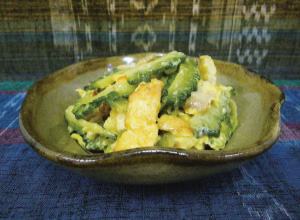
- ■ Ingredients
- Goya (bitter gourd) 400g
- Shima dofu (Okinawan-style tofu) 400g
- pork rib 120~160g
- 2 eggs
- oil used for frying Tablespoon2
- a suitable amount of salt
- ①Boil the block of pork rib and cut it into rectangular slices
- ②Wash Goya and cut in half vertically. Then take out the seeds and cotton with a spoon. Slice it thinly, put salt on it, and squeeze the water lightly.
- ③Wipe off the water on tofu.
- ④Put 1 tablespoon of oil in a pan, add tofu torn off by hand, and fry it. When it’s browned, take it on a plate.
- ⑤Put the rest of oil in a pan and fry pork rib over a high flame. Add the Goya in (2) and season with salt, then add the tofu in (4).
- ⑥Pour beaten eggs into (5), and mix them well for finishing.
■Chanpuru is a dish of fried Okinawan-style tofu and seasonal vegetables. Fry it crisply without making it watery.
- Boiled Swiss chard
- Dish of Swiss chard, tofu and pork boiled in miso broth
Boiled Swiss chard
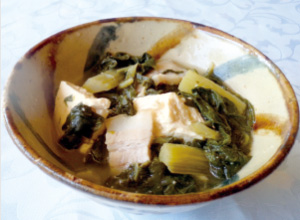
- ■ Ingredients
- Swiss chard 800g
- pork rib 80g
- Shima dofu (Okinawa-style tofu) 400g
- pork broth 1C強
- strong red miso Tablespoon4
- oil Tablespoon1 1/2
- ①Separate leaves and stems of Swiss chard. Boil it and put it in water. Cut it into 3-4cm long and squeeze it to drain.
- ②Boil the block of pork rib, and cut it into rectangular slices.
- ③Heat oil in a pot, and put pork rib in the pot. When the fat comes out of the pork, add Swiss chard and fry it.
- ④Add red miso dissolved in pork broth to (3), and boil it over a medium flame. Tear tofu into pieces by hand and add it in the pot. When the flavor is infiltrated into the ingredients, turn off the fire.
- Mimiga (pig’s ear skin) sashimi
- Boiled and shredded pig ears with dressing
Mimiga (pig’s ear skin) sashimi
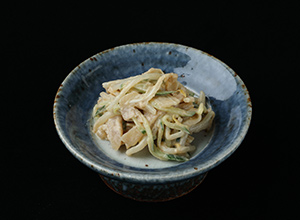
- ■ Ingredients
- pig’s ear skin 100g
- cucumber 100g
- sprouts 50g
- [Peanuts vinegar]
- peanuts butter Tablespoon2
- sugar Teaspoon1/4
- salt Teaspoon1/2
- vinegar Tablespoon2
- ①Broil the pig’s ear skin on an open fire, scrape off hair on it, and wash it. Then boil it for about 30 minutes.
- ②Shred the ear skin finely (shredded ones are sold at stores), and season with a lot of salt, then leave it for a while. Boil it quickly, and wash it well, by rubbing it (remove saltiness, greasiness and smell). Then let the water drain off.
- ③Shred a cucumber slantingly. Wash sprouts and boil them quickly, then let the water drain off and cool them down.
- ④Put the seasoning together, and make peanuts vinegar.
- ⑤Put the ear skin, cucumber, and sprouts together, and dress them with peanuts vinegar.
- Boiled fish paste
- Okinawan style boiled fish paste fixed as a method to preserve fish in a hot area.
Boiled fish paste

- ■ Ingredients
- fish (paste) 200g
- salt Teaspoon1/2
- sugar Tablespoon/2
- sweet cooking sake Tablespoon1
- egg white 1/2個分
- potato starch Tablespoon1
- water Tablespoon2
- a suitable amount of kelp
- ①Fillet a fish and remove fish meat with a bloody color and small bones carefully. Scrape the fish meat off with a spoon.
- ②Beat the fish meat in (1) on a cutting board, put it in a mortar and grind it well until it becomes sticky.
- ③Add a suitable amount of salt to the mortar in (2) and grind and mix them for about 10 minutes. Put sugar, sweet cooking sake, egg white, and potato starch in the mortar in that order, and grind and mix them well. Further grind and mix them until they become smooth, by adding water little by little.
- ④Beat the fish meat in (3) on the cutting board to tighten it. Put the fish meat on the rehydrated kelp and make a semi-cylindrical shape.
- ⑤Put it in a heated steamer and steam it for about 30 minutes.
■Color the surface with red food coloring after steaming to make red boiled fish paste.
- Boiled fish paste with leaf mustard
- Boiled fish paste that added the color and flavor of leaf mustard
Boiled fish paste with leaf mustard
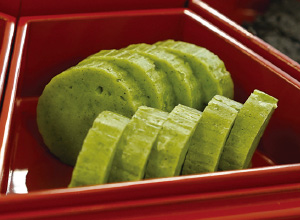
- ■ Ingredients
- fish paste (commercially available) net300g
- a suitable amount of leaf mustard
- a suitable amount of dried kelp
- ①Chop leaf mustard finely and put the chopped leaf mustard and water in a blender, then put it in a bag and squeeze it.
- ②Boil the squeezed juice in a pot. When the thickened part comes to the surface, scoop it quickly and cool it down. [Thickening green]
- ③Add the thickened part to fish paste and grind it in a mortar, and color the fish paste green.
- ④Spread a cellophane film on a rolling mat, put the fish paste in (3) and roll it. Steam it over a high flame for the first 2-3 minutes, then turn down the flame to medium one and steam it for about 20 minutes.
■It is desirable to use dark colored leaf mustard.
■If you prepare fish paste by yourself, you should use the thick squeezed juice of leaf mustard instead of water.
■When you check the degree of coloration, you can check that by pouring a small amount of the paste into hot water.
- Boiled meat and fish paste
- High-grade boiled pork loin paste and fish paste
Boiled meat and fish paste

- ■ Ingredients
- pork loin net300g
- salt Tablespoon1/2
- sugar Tablespoon1
- sweet cooking sake Tablespoon2
- egg white 1/2個分
- potato starch Tablespoon2
- water 1/4C
- a small amount of red food coloring
- fish paste (commercially available) net300g
- ①Chop pork loin and beat it. Put this in a mortar and grind it until it becomes sticky. Add a suitable amount of salt, sugar, sweet cooking sake, egg white, and potato starch in that order, and grind and mix them well.
- ②Add water to the ingredients in (1) little by little, grind and mix them until they become smooth, and make meat paste.
- ③Mix half of the fish paste with the meat paste and put a small amount of red food coloring dissolved in water to color the paste into pale pink.
- ④Apply a lot of oil to a rolling mat, put the colored paste in (3) on the rolling mat, and level out the paste with a wet knife.
- ⑤Add the fish paste on the rolling mat in (4), and level it out. Roll it from your side, making spiral shape, and hold the end with a rubber band. Put the spiral on a steamer, making the hiragana character of “no”.
- ⑥Steam the paste in the heated steamer over a high flame for the first 2-3 minutes, then turn down the flame to medium one and steam it for about 40 minutes. When it’s steamed, cut it into 7-10mm long.
■If you put each paste on a certain size of a cellophane film, wrap the paste with the film, and spread the paste with a rolling pin, you can easily spread the paste.
■When you check the degree of coloration of the pork paste, you can check that by pouring a small amount of the paste into hot water.
- Hanbin
- Color the paste of pork loin pink, and put fish paste on it, and roll it making the hiragana character of “no”.
Hanbin
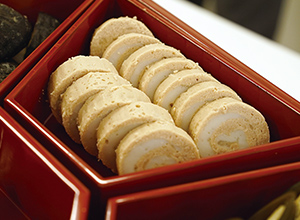
- ■ Ingredients
- minced pork meat 450g
- (pork loin without fat)
- egg white
- potato starch
- red food coloring
- fish paste 150g
- ①Put minced pork meat in a mortar, add egg white and potato starch to it, and grind it, checking the flavor. Color it with red food coloring.
- ②Spread a cellophane film on a rolling mat, put the minced pork meat on the mat and spread it thinly. Then, put a little amount of potato starch on it and spread fish paste on it.
- ③Roll it making the hiragana character of “no”, and steam it in a steamer for about 20 minutes.
■When you check the degree of coloration of the pork paste, you can check that by pouring a small amount of the paste into hot water.
- Flowered squid
- Boil cuttlefishes with complicated cuts and open the cuts beautifully
Flowered squid
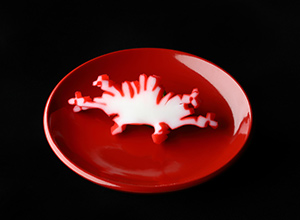
- ■ Ingredients
- cuttlefishes
- a suitable amount of salt
- a small amount of red food coloring
- vinegar
- soy sauce
- ①Open the body of cuttlefishes, remove the skin, leaving pulps, and wash them well.
- ②Put salt on cuttlefishes, and tighten the body.
- ③Cut and divide cuttlefishes into fillets.
- ④Make cuts on cuttlefishes with a sharp knife.
- ⑤Wash the cuts in water without adhering the cuts to the others, and take out the sliminess.
- ⑥Boil the cuttlefishes moderately. Check the opening of cuts, and if it’s not enough, make cuts more.
- ⑦Dissolve the red food coloring in water and boil it. Color the cuttlefishes red evenly. You can use cuttlefishes without coloring.
- ⑧Dry the cuttlefishes by placing upright, cut them into 7mm thick horizontally, and serve them with vinegar and soy sauce.
■Cuttlefishes tend to bend vertically.
■They have strong fibers running horizontally.
■If you make complicated cuts on cuttlefishes that have a thick body and boil them, the cuts will make a various kinds of shapes.
- Kutempura (small tempura)
- Sticks of white fish tempura
Kutempura (small tempura)
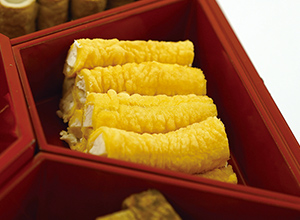
- ■ Ingredients
- white fish (swordfish) 200g
- [batter]
- 2 egg yolks
- soft flour 1C
- a suitable amount of water
- a suitable amount of oil used for frying
- ①Cut small tempura into sticks of 1 cm square in diameter and 7cm long, and put salt on the sticks.
- ②Make batter with egg yolks, soft flour and water.
- ③Heat oil on an oil pan, and fry white fish with batter (Put flour on fish thinly).
■Cut both ends of the sticks and arrange them on a plate.
- Fried taimo
- Fried taimo with salty-sweet sauce of sugar and soy sauce
Fried taimo
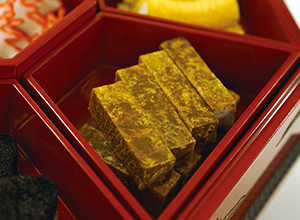
- ■ Ingredients
- 2 large taimo
- soy sauce Tablespoon4
- sugar Tablespoon2
- rock sugar Tablespoon2
- a suitable amount of oil used for frying
- ①Put suitable amounts of ingredients together and boil them to make sauce.
- ②Peel taimo, cut them into favorite shapes and fry them crisply with heated oil. Put the fried taimo in the sauce quickly.
■There are half circle slices instead of rectangles.
- Sweet potato starch andagi
- Fries made from sweet potatoes and sweet potato starch
Sweet potato starch andagi
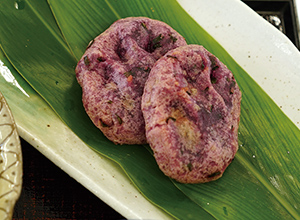
- ■ Ingredients
- sweet potatoes (net)300g
- sweet potato starch 210g
- dried bonito broth 150~160cc
- salt Teaspoon1 1/2
- Chinese chives 45g(1/2C)
- a suitable amount of oil used for frying
- ①Wash sweet potatoes, cut them into 3-4 equal pieces and peel the skin thickly. Soak them into water to remove astringent taste, and steam them (boil them).
- ②Strain the cooked sweet potatoes while they are still hot, or mash them(300g).
- ③Wash Chinese chives and let the water drain off, then cut it into 5mm long.
- ④Dissolve salt in a suitable amount of dried bonito broth.
- ⑤Put sweet potato starch in a bowl, add the broth in (4) to it little by little and mix them. Add the sweet potatoes in (1), kneading them to produce a proper hardness.
- ⑥Add Chinese chives to (5) and mix them lightly.
- ⑦Take a scoop of (6) and bunch it up together. When it takes a high polish, make oval shapes and put finger signs on them.
- ⑧Heat the oil for frying to medium temperature (170 ℃) and put (7) in the oil. When they come to the surface, turn them over and fry them for several minutes for crispy finish.
■If the dough is too soft, strain the sweet potato starch with a strainer, and use it by making it in powder form.
- Chiirunko
- Steamed cakes with red colored peanuts and Chippan with lots of eggs
Chiirunko
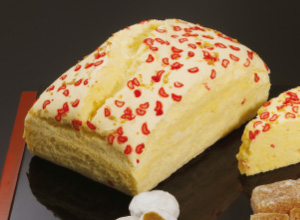
- ■ Ingredients
- [For a wooden flame of 12㎝ × 21㎝ × 6㎝]
- soft flour 105g
- white superior soft sugar 105g
- 2 eggs
- 2 egg yolks
- salad oil Tablespoon1
- 10 raw peanuts
- 3 pieces of Chippan
- a suitable amount of red food coloring
- [Spread a sheet of paper on a wooden flame and put it in a steamer]
- ①Soak raw peanuts in hot water for a while and peel the skin of them. Dye peanuts by putting them in water-blended red food coloring. When the moisture has gone after dyeing, slice the peanuts.
- ②Remove the frosting of Chippan, and mince them. (Chippan without frosting is also sold.)
- ③Separate part of (1) and (2) as a decoration.
- ④Put 2 eggs and 2 egg yolks in a bowl and whip them. Add sugar and whip them well for about 10 minutes. (When you start whipping, you should put the bowl in a hot water bath to warm it until the temperature of human skin before whipping.)
- ⑤Add sieved soft flour to (4) and mix them, and when flouriness has gone, add peanuts in (3) and Chippan, and mix them well.
- ⑥Put the wooden flame in a steamer and pour the dough into it. Sprinkle the peanuts and Chippan on the top as a decoration, steam them in a heated steamer for about 25 minutes.
- Flower Bowl
- Beauty of cutting/The baked sweets that attracted even Edo.
Flower Bowl
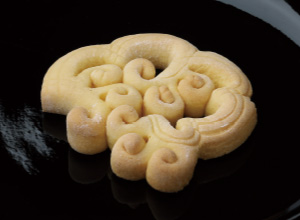
- ■ Ingredients
- 2 egg yolks
- white soft sugar (the same amount as that of egg yolks)
- soft flour 90~100g
- baking powder Teaspoon1/2
- ①Put egg yolks in a bowl and dissolve them well. Then add white soft sugar, and mix them well.
- ②Sieve the flour and add it to (1) and mix them well. Adjust the toughness of the dough so that a knife can cut it.
- ③Put dusting agent on a cutting board, cut the dough, and shape it. Bake it at 150℃ for about 15 minutes.
- Kunpen
- Baked sweets―sesame paste is wrapped by a thin skin made from egg yolks, flour and sugar
Kunpen
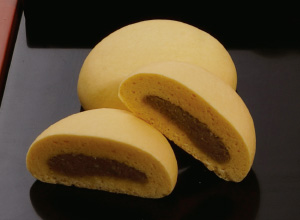
- ■ Ingredients
- [Skins]
- 2 egg yolks
- white soft sugar (the same amount as that of egg yolks)
- soft flour 80~100g
- baking powder Teaspoon2/3
- [sesame paste]
- white sesame 20g
- Chippan (Kippan) 1/4
- granulated sugar 25g
- ①Make the skins.
- ②Put egg yolks in a bowl and whip them well. Add white soft sugar and mix them well. Sieve the flour and add it to that, mix them well and divide them into six parts.
- ③Make sesame paste. Roast white sesame and grind it. Add granulated sugar and chopped Chippan and mix them well. Divide it into 6 equal pieces and make them round.
- ④Wrap sesame paste in (3) with the skins in (1). Make flat round shape and bake them at 150℃ for about 12 minutes.
■Put the sweets in a well-closed container just after they are baked.
- Chinsuko
- Baked sweets made from flour, sugar and Lard
Chinsuko
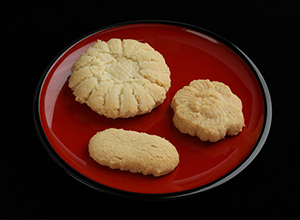
- ■ Ingredients
- flour 200g
- white soft sugar 150g
- lard 100g
- ①Sieve flour and white soft sugar.
- ②Put lard in a bowl and mix well with a wooden ladle until it becomes smooth. Then add white soft sugar so that it can include air well.
- ③Cool the mixed stuff in (2) at a refrigerator, and harden the lard.
- ④Add flour to (3) and mix the flour and lard well with a scraper, mincing the ingredients.
- ⑤Cut (4) with a cutter and shape them by hand, and bake them at 150℃with an oven for 30 minutes.
- Sata andagi
- Okinawan sweet deep-fried bun made from eggs, sugar and flour
Sata andagi

- ■ Ingredients
- 2 eggs (M size)
- granulated sugar 115g
- flour 200~220g
- baking powder Teaspoon2
- salad oil Teaspoon2
- a suitable amount of oil used for frying
- ①Sieve flour and baking powder together.
- ②Put 2 eggs in a bowl and whip them. Add sugar and mix them well without beating them.
- ③Add flour in (1) to (2) and mix them well. Add salad oil and mix them further.
- ④Put a little oil on the hands and make small balls of 2 cm in diameter. Put the balls in oil at 150-160℃.
- ⑤The balls will sink to the bottom at the beginning, but they will slowly come up to the surface in 20-30 seconds. The balls will blow up, rotating, and one point will break up and open to a tulip shape.
- ⑥When they become brownish and they’re stuck through on a bamboo stick and raw dough doesn’t stick to it, they’re done.
- Nattsunsu
- Fragrant rice cakes with miso and long peppers
Nattsunsu
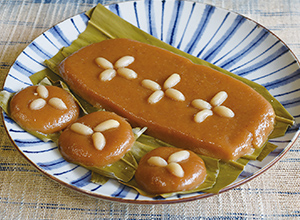
- ■ Ingredients
- sticky rice flour 1 1/2C
- sugar (coarse sugar) 3/4C
- water 1/2C
- dark-brown miso 50g
- peanuts butter Tablespoon1
- long peppers (seasoning) Teaspoon1/2
- 8 raw peanuts
- 1 leaf of Spanish Jasmine
- ①Dissolve coarse sugar in boiled water, and cool it down.
- ②Mix sticky rice flour and powder of long peppers.
- ③Put sticky rice flour in (2) in a bowl, add the molasses in (1) little by little, and knead them, forming dough like ear lobes. Add miso and peanuts butter, and knead them well.
- ④Put the dough in (3) on the back side of a leaf of Spanish Jasmine, and form a rectangle shape. Then put raw peanuts on it, making four flower petals.
- ⑤Steam the dough in a heated steamer over a high flame for the first 2-3 minutes, then turn down the flame to medium one, and steam it for about 40 minutes.

